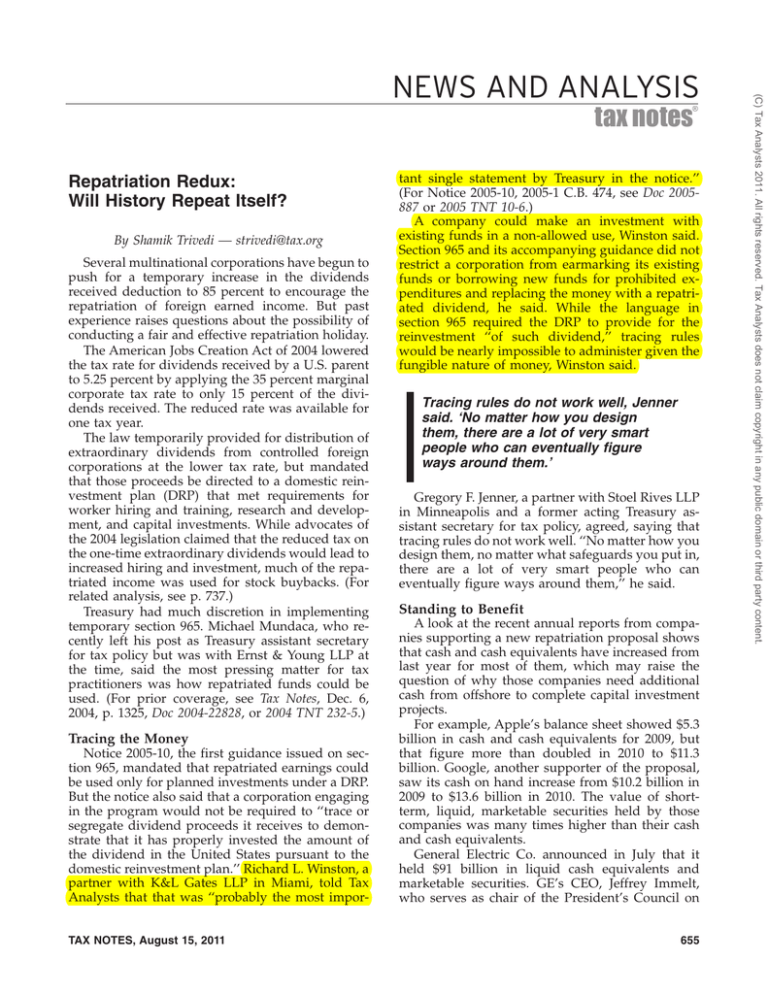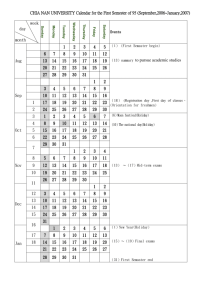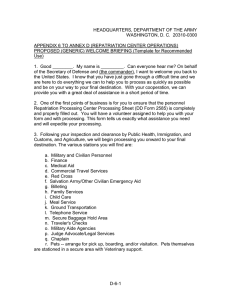
®
tax notes
Repatriation Redux:
Will History Repeat Itself?
By Shamik Trivedi — strivedi@tax.org
Several multinational corporations have begun to
push for a temporary increase in the dividends
received deduction to 85 percent to encourage the
repatriation of foreign earned income. But past
experience raises questions about the possibility of
conducting a fair and effective repatriation holiday.
The American Jobs Creation Act of 2004 lowered
the tax rate for dividends received by a U.S. parent
to 5.25 percent by applying the 35 percent marginal
corporate tax rate to only 15 percent of the dividends received. The reduced rate was available for
one tax year.
The law temporarily provided for distribution of
extraordinary dividends from controlled foreign
corporations at the lower tax rate, but mandated
that those proceeds be directed to a domestic reinvestment plan (DRP) that met requirements for
worker hiring and training, research and development, and capital investments. While advocates of
the 2004 legislation claimed that the reduced tax on
the one-time extraordinary dividends would lead to
increased hiring and investment, much of the repatriated income was used for stock buybacks. (For
related analysis, see p. 737.)
Treasury had much discretion in implementing
temporary section 965. Michael Mundaca, who recently left his post as Treasury assistant secretary
for tax policy but was with Ernst & Young LLP at
the time, said the most pressing matter for tax
practitioners was how repatriated funds could be
used. (For prior coverage, see Tax Notes, Dec. 6,
2004, p. 1325, Doc 2004-22828, or 2004 TNT 232-5.)
Tracing the Money
Notice 2005-10, the first guidance issued on section 965, mandated that repatriated earnings could
be used only for planned investments under a DRP.
But the notice also said that a corporation engaging
in the program would not be required to ‘‘trace or
segregate dividend proceeds it receives to demonstrate that it has properly invested the amount of
the dividend in the United States pursuant to the
domestic reinvestment plan.’’ Richard L. Winston, a
partner with K&L Gates LLP in Miami, told Tax
Analysts that that was ‘‘probably the most imporTAX NOTES, August 15, 2011
tant single statement by Treasury in the notice.’’
(For Notice 2005-10, 2005-1 C.B. 474, see Doc 2005887 or 2005 TNT 10-6.)
A company could make an investment with
existing funds in a non-allowed use, Winston said.
Section 965 and its accompanying guidance did not
restrict a corporation from earmarking its existing
funds or borrowing new funds for prohibited expenditures and replacing the money with a repatriated dividend, he said. While the language in
section 965 required the DRP to provide for the
reinvestment ‘‘of such dividend,’’ tracing rules
would be nearly impossible to administer given the
fungible nature of money, Winston said.
Tracing rules do not work well, Jenner
said. ‘No matter how you design
them, there are a lot of very smart
people who can eventually figure
ways around them.’
Gregory F. Jenner, a partner with Stoel Rives LLP
in Minneapolis and a former acting Treasury assistant secretary for tax policy, agreed, saying that
tracing rules do not work well. ‘‘No matter how you
design them, no matter what safeguards you put in,
there are a lot of very smart people who can
eventually figure ways around them,’’ he said.
Standing to Benefit
A look at the recent annual reports from companies supporting a new repatriation proposal shows
that cash and cash equivalents have increased from
last year for most of them, which may raise the
question of why those companies need additional
cash from offshore to complete capital investment
projects.
For example, Apple’s balance sheet showed $5.3
billion in cash and cash equivalents for 2009, but
that figure more than doubled in 2010 to $11.3
billion. Google, another supporter of the proposal,
saw its cash on hand increase from $10.2 billion in
2009 to $13.6 billion in 2010. The value of shortterm, liquid, marketable securities held by those
companies was many times higher than their cash
and cash equivalents.
General Electric Co. announced in July that it
held $91 billion in liquid cash equivalents and
marketable securities. GE’s CEO, Jeffrey Immelt,
who serves as chair of the President’s Council on
655
(C) Tax Analysts 2011. All rights reserved. Tax Analysts does not claim copyright in any public domain or third party content.
NEWS AND ANALYSIS
NEWS AND ANALYSIS
Depending on Tax Reform
Treasury Secretary Timothy Geithner has criticized the 2004 repatriation holiday as expensive
and as having failed to increase investment or job
creation. He has said that while the Obama administration is open to a repatriation holiday, it must be
part of a broader corporate tax reform effort.
Geithner has said that while the
administration is open to a
repatriation holiday, it must be part of
a broader corporate tax reform effort.
House Ways and Means Committee Chair Dave
Camp, R-Mich., has also expressed a preference for
moving the proposal as part of a broader tax reform
effort.
The Bipartisan Tax Fairness and Simplification
Act of 2011 (S. 727), sponsored by Senate Finance
Committee member Ron Wyden, D-Ore., and Sen.
656
Daniel Coats, R-Ind., would cut the corporate tax
rate from 35 to 24 percent, eliminate several tax
credits and deductions, and allow a one-year repatriation holiday. (For S. 727, see Doc 2011-7271 or
2011 TNT 66-29.)
Questioning Effectiveness
According to Winston, if a company directs repatriated dividends for a specific purpose, it may have
planned to use its preexisting cash reserves or take
out a loan to finance that project already. A repatriation holiday may help those companies but
would not accomplish the goal of creating new
capital investments, he said.
Perhaps the biggest reason a repatriation holiday
would not accomplish its stated goal is the timing of
the basic business cycle, Winston said. Companies
do not make capital investment decisions based on
one- or two-year periods, he said. Most companies
plan five years or more in advance, so legislation
mandating that repatriated earnings be used in a
specific manner would leave those companies with
relatively little time to plan costly and complicated
capital investment projects, he said.
Winston said his major concern with a repatriation holiday is its inherent inconsistency. Businesses
cannot rely on a repatriation holiday, even if one is
expected to happen again, because they can’t be
certain when it will occur, he said.
As in 2004, a new repatriation holiday is being
touted by supporters as a measure that will increase
capital investment and create jobs. The Win
America Campaign, a prominent supporter of the
holiday, cited a 2008 study showing that contrary to
popular belief, after the American Jobs Creation Act
of 2004, 23 percent of repatriated dividends went
toward hiring and training U.S. employees.
That is disputed by Steve Wamhoff, legislative
director for Citizens for Tax Justice. It’s clear that
the 2004 legislation did not create jobs, he told Tax
Analysts, citing other research conducted after the
holiday. The benefits of repatriation went toward
stock buybacks, not job creation, he said.
William C. Miller Jr., senior vice president for
political affairs and federation relations for the U.S.
Chamber of Commerce, said a repatriation holiday
should be embraced by Congress because it would
raise much-needed revenue. Regardless of the situation in 2004, ‘‘there is a huge amount of money that
exists overseas that could be taxed that would be of
benefit to the U.S. treasury that is not benefiting the
U.S. treasury today,’’ he said.
Multinationals won’t bring that money back if
they will be double taxed, so ‘‘policymakers can
look at this from a pure revenue perspective,’’
Miller said. ‘‘This is an opportunity to bring scarce
revenue into the treasury’s coffers,’’ he added.
TAX NOTES, August 15, 2011
(C) Tax Analysts 2011. All rights reserved. Tax Analysts does not claim copyright in any public domain or third party content.
Jobs and Competitiveness, said July 11 that he
supports a repatriation holiday. (For prior coverage,
see Tax Notes, July 18, 2011, p. 231, Doc 2011-15081,
or 2011 TNT 133-3.)
According to the IRS’s spring 2008 Statistics of
Income Bulletin, of the approximately 9,700 eligible
corporations — those with CFCs — only 843 participated in the 2004 repatriation program. However, those companies repatriated nearly $362
billion, an average of $429 million per company.
(For the SOI Bulletin, see Doc 2008-13172 or 2008
TNT 116-54.)
Pharmaceutical companies, which represented
just 3 percent of the total returns filed, claimed 29.2
percent of the cash dividends and 31.6 percent of
qualifying dividends, according to the report. They
were highly efficient at ensuring that dividends
were qualified. The study indicates that the average
cash dividend for the industry was $3.64 billion,
and the average qualifying dividend was $3.41
billion. As a percentage of cash dividends, pharmaceutical companies’ qualifying dividends were 93.6
percent. The average for all companies was 86.3
percent.
More than half of the corporations in the report
identified themselves as manufacturers. Those 465
companies had average total assets of $12.7 billion,
with their total share of repatriated dividends representing 80 percent of the total dividends.
Manufacturers like GE, Pfizer, Kodak, Microsoft,
Cisco, and Apple support the latest round of legislation to allow for a one-year repatriation holiday.
All have much to gain should the proposal become
law, but right now prospects are dim, at least for
stand-alone legislation.
NEWS AND ANALYSIS
Skip the Window Dressing
Like Jenner, Wamhoff is skeptical that legislation
could be written that would ensure the use of
repatriated dividends for specific purposes. ‘‘That’s
what Congress tried last time,’’ he said. ‘‘You can’t
tell a corporation what to do with its money,
because they’ll always find a way around that.’’
‘You can’t tell a corporation what to
do with its money, because they’ll
always find a way around that,’
Wamhoff said.
Jenner said that if he had to design a repatriation
holiday proposal, he would remove restrictions on
how the money is spent. ‘‘Why create either traps
for the unwary . . . or hurdles that we all know are
out there? If you want to bring this money back, let
the companies bring it back and skip the window
dressing,’’ he said.
Some congressional Democrats have followed
that path in arguing for a holiday. Rep. Jared Polis,
D-Colo., a cosponsor of a stand-alone repatriation
holiday bill, the Freedom to Invest Act of 2011 (H.R.
1834), has said that Congress should not tell companies how to spend the money. (For the bill, see
Doc 2011-10228 or 2011 TNT 92-28.)
Rep. Loretta Sanchez, D-Calif., was unequivocal
in her stance that repatriated dividends should be
used for whatever purpose the companies see fit.
Even if a company used the dividends to buy back
its stock, that decision still benefited its investors
and the economy, she said on June 15, adding, ‘‘If I
was a stockholder in that company, I did well.’’ (For
prior coverage, see Tax Notes, June 20, 2011, p. 1225,
Doc 2011-13117, or 2011 TNT 116-3.)
One possible alternative to the 85 percent dividends received deduction would be to structure the
incentive as a recapturable tax credit, with companies applying through a competitive process. Companies that fail to meet criteria mandated by the
government, perhaps in the form of capital investments or hiring objectives, would see those credits
recaptured.
A tax director at a multinational technology
company that benefited from the previous repatriation holiday said that businesses would likely not
TAX NOTES, August 15, 2011
be amenable to that kind of program. Speaking on
condition of anonymity, he said he could envision
legislation that could effectively link job creation or
maintenance to receiving the dividend, but that a
government mandate to do so would be bad public
policy and would go against free market principles.
For most multinational companies, high costs are a
disincentive to hire people in the United States, and
jobs and tax benefits are not really connected, he
said.
Rewarding Offshoring?
Critics of the proposal have likened the repatriation holiday to a tax amnesty for major multinational corporations, and they fear that Congress’s
concessions now will only encourage companies to
leave cash abroad.
‘‘Corporations will respond by pushing even
more profits and investment offshore,’’ Wamhoff
said. A repatriation holiday will give incentives to
corporations to leave profits offshore because it will
show that Congress is willing to allow another
holiday, he said.
Winston said that ‘‘consistency is a way to let the
players who function in a competitive environment
effectively make their long-term plans.’’ A repatriation holiday that randomly occurs every so often
will usually be ineffective, and some companies will
respond by intentionally holding their earnings
offshore until the next holiday, he said.
The 2004 Jobs Act was a great opportunity for
many companies, but if it’s done again so soon, ‘‘we
may never recover,’’ Winston said.
657
(C) Tax Analysts 2011. All rights reserved. Tax Analysts does not claim copyright in any public domain or third party content.
Wamhoff disagreed. He cited a report by the Joint
Committee on Taxation estimating that a repatriation holiday would cost about $79 billion over 10
years. He disputed the notion that it could be scored
as a revenue raiser, saying that analysis takes into
consideration only a short period, not a 10-year
window. (For the report, see Doc 2011-10226 or 2011
TNT 92-37.)




